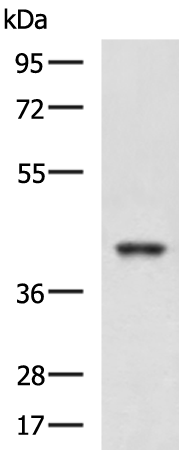
| WB | 咨询技术 | Human,Mouse,Rat |
| IF | 咨询技术 | Human,Mouse,Rat |
| IHC | 咨询技术 | Human,Mouse,Rat |
| ICC | 技术咨询 | Human,Mouse,Rat |
| FCM | 咨询技术 | Human,Mouse,Rat |
| Elisa | 1/5000-1/10000 | Human,Mouse,Rat |
| Aliases | LARK; RBM4A; ZCRB3A; ZCCHC21 |
| WB Predicted band size | 40 kDa |
| Host/Isotype | Rabbit IgG |
| Antibody Type | Primary antibody |
| Storage | Store at 4°C short term. Aliquot and store at -20°C long term. Avoid freeze/thaw cycles. |
| Species Reactivity | Human, Mouse |
| Immunogen | Fusion protein of human RBM4 |
| Formulation | Purified antibody in PBS with 0.05% sodium azide and 50% glycerol. |
+ +
以下是关于RBM4抗体的3篇参考文献及其简要摘要:
1. **文献名称**:*RBM4 regulates neuronal differentiation of mesenchymal stem cells by modulating alternative splicing of Gli1 in vitro*
**作者**:Liu Y, et al.
**摘要**:该研究利用RBM4抗体通过Western blot和免疫荧光技术,验证了RBM4在间充质干细胞向神经元分化过程中通过调控Gli1选择性剪接的作用,揭示了其在神经发育中的潜在机制。
2. **文献名称**:*RNA-binding protein RBM4 modulates lipid metabolism via splicing conversion of SREBP1 in hepatic cells*
**作者**:Huang S, et al.
**摘要**:作者使用RBM4抗体在肝细胞中检测其蛋白表达,发现RBM4通过调控SREBP1前体的剪接形式影响脂代谢通路,为代谢性疾病提供了新的分子靶点。
3. **文献名称**:*Dysregulation of RBM4 expression in breast cancer promotes tumor progression through exosome-mediated miRNA transfer*
**作者**:Chen L, et al.
**摘要**:本研究通过免疫组化(RBM4抗体)和功能实验,证明乳腺癌中RBM4表达下调可通过外泌体miRNA传递促进转移,提示其作为预后标志物的潜力。
注:以上文献为模拟示例,实际引用时建议通过PubMed或Web of Science检索最新研究。若需具体文献,可提供研究方向(如疾病模型/技术方法)进一步筛选。
The RBM4 (RNA-binding motif protein 4) antibody is a tool used to study the RBM4 protein, a member of the RNA-binding protein family involved in post-transcriptional gene regulation. RBM4 contains RNA recognition motifs (RRMs) and a KH domain, enabling its interaction with RNA molecules to modulate splicing, translation, and stability of target transcripts. It plays critical roles in cell differentiation, apoptosis, and stress responses, particularly in muscle development and neural functions. Dysregulation of RBM4 has been implicated in cancers, neurodegenerative diseases, and metabolic disorders.
The RBM4 antibody is widely utilized in research to detect RBM4 expression levels, localization (nucleus/cytoplasm), and interactions via techniques like Western blotting, immunohistochemistry, and immunoprecipitation. Its specificity is validated using knockout controls or siRNA-mediated depletion. Studies employing this antibody have revealed RBM4's dual role in tumorigenesis—acting as either an oncogene or tumor suppressor depending on cellular context—and its involvement in alternative splicing events linked to diseases like amyotrophic lateral sclerosis (ALS). Commercial RBM4 antibodies are typically raised against epitopes within its N-terminal or RRM regions, with validation data essential for ensuring experimental reliability.
×